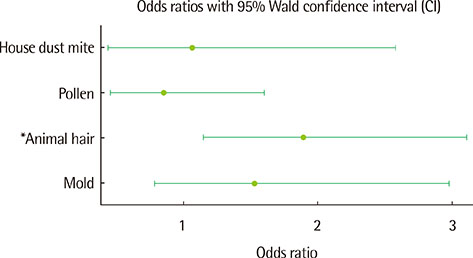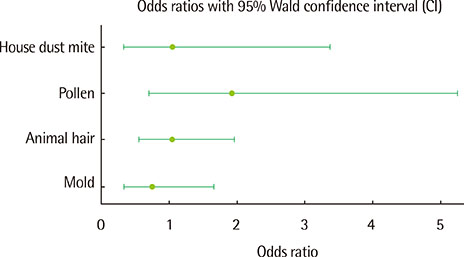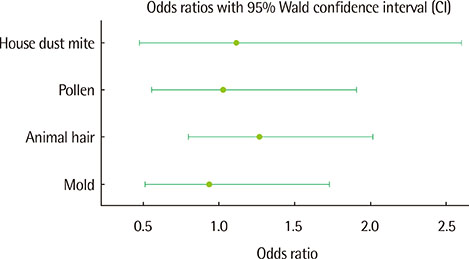Clinical features of allergic rhinitis in Korean children
- Affiliations
-
- 1Department of Pediatrics, Inha University School of Medicine, Incheon, Korea. kimjhmd@inha.ac.kr
- 2Environmental Health Center for Allergic Rhinitis, Inha University Hospital, Incheon, Korea.
- KMID: 2168503
- DOI: http://doi.org/10.4168/aard.2015.3.2.116
Abstract
- PURPOSE
The characteristics of allergic rhinitis can be different among countries and areas because causative allergens and aggravating factors depend on the living environment. However, there have been few studies on the clinical feature of Korean children with allergic rhinitis, as well as on clinical characteristics in different age groups. The aim of this study was to investigate the clinical characteristics of Korean children with allergic rhinitis.
METHODS
The medical records of children under 12 years of age who had rhinitis symptoms were analyzed in terms of clinical symptoms and positive allergens. Subjects were classified into 2 groups: those with allergic rhinitis (AR group) and nonallergic rhinitis (NAR group). Both groups were subdivided into 3 categories: the 1-4 years, 5-8 years, and 9-12 age groups.
RESULTS
Among 516 children, 397 (76.94%) belonged to the AR group and 119 (23.06%) belonged to the NAR group. The male to female ratios were 2:1 in both groups. There were significant differences in sneezing and itching between the AR and NAR groups across different age subgroups. There were significant differences in nasal obstruction between the AR and NAR groups in the 9-12 age group. The incidence of AR was 77.8 % in chronic sinusitis patients. Sensitized allergens were house dust mites, animal hair, pollen, and mold in decreasing order in the AR group. Children who were sensitized to animal hair more frequently had sneezing than those who were not.
CONCLUSION
Sneezing and itching strongly suggest allergic rhinitis in Korean children. Clinical characteristics of allergic rhinitis in Korean children would helpful in early diagnosis and adequate treatment of disease.
MeSH Terms
Figure
Cited by 4 articles
-
Validation of "quality-of-life questionnaire in Korean children with allergic rhinitis" in middle school students
Ha Young Kang, Seung Hyun Moon, Hae Ji Jang, Dae Hyun Lim, Jeong Hee Kim
Allergy Asthma Respir Dis. 2016;4(5):369-373. doi: 10.4168/aard.2016.4.5.369.Association between the serum 25-hydroxyvitamin D level and allergic rhinitis in Korean children
Seo Hee Yoon, Jung Yoon Kim, Yoon Hee Kim, Young A Park, In Suk Sol, Min Jung Kim, Kyung Won Kim, Myung Hyun Sohn, Kyu-Earn Kim
Allergy Asthma Respir Dis. 2016;4(6):423-428. doi: 10.4168/aard.2016.4.6.423.Research on pediatric allergic rhinitis in Korea
Kyung Suk Lee, Yeong Ho Rha
Allergy Asthma Respir Dis. 2018;6(Suppl 1):S58-S65. doi: 10.4168/aard.2018.6.S1.S58.Clinical characteristics of allergic rhinitis and nonallergic rhinitis in Korean children
Na Hae Won, Sang Hyun Park, So Hyun Ahn, Chae Bong Kim, Jung Hyun Kwon, Won Hee Seo, Dae Jin Song, Young Yoo
Allergy Asthma Respir Dis. 2020;8(1):20-29. doi: 10.4168/aard.2020.8.1.20.
Reference
-
1. Bousquet J, Khaltaev N, Cruz AA, Denburg J, Fokkens WJ, Togias A, et al. Allergic Rhinitis and its Impact on Asthma (ARIA) 2008 update (in collaboration with the World Health Organization, GA(2)LEN and AllerGen). Allergy. 2008; 63:Suppl 86. 8–160.2. Long A, McFadden C, DeVine D, Chew P, Kupelnick B, Lau J. Management of allergic and nonallergic rhinitis. Evid Rep Technol Assess (Summ). 2002; (54):1–6.3. Bauchau V, Durham SR. Prevalence and rate of diagnosis of allergic rhinitis in Europe. Eur Respir J. 2004; 24:758–764.
Article4. Bachert C, van Cauwenberge P, Olbrecht J, van Schoor J. Prevalence, classification and perception of allergic and nonallergic rhinitis in Belgium. Allergy. 2006; 61:693–698.
Article5. Nathan RA, Meltzer EO, Derebery J, Campbell UB, Stang PE, Corrao MA, et al. The prevalence of nasal symptoms attributed to allergies in the United States: findings from the burden of rhinitis in an America survey. Allergy Asthma Proc. 2008; 29:600–608.
Article6. Bjorksten B, Clayton T, Ellwood P, Stewart A, Strachan D. ISAAC Phase III Study Group. Worldwide time trends for symptoms of rhinitis and conjunctivitis: phase III of the International Study of Asthma and Allergies in Childhood. Pediatr Allergy Immunol. 2008; 19:110–124.
Article7. Hong SJ, Ahn KM, Lee SY, Kim KE. The prevalences of asthma and allergic diseases in Korean children. Korean J Pediatr. 2008; 51:343–350.
Article8. Jee HM, Kim KW, Kim CS, Sohn MH, Shin DC, Kim KE. Prevalence of asthma, rhinitis and eczema in korean children using the international study of asthma and allergies in childhood (ISAAC) questionnaires. Pediatr Allergy Respir Dis. 2009; 19:165–172.9. Ahn K, Kim J, Kwon HJ, Chae Y, Hahm MI, Lee KJ, et al. The prevalence of symptoms of asthma, allergic rhinoconjunctivitis, and eczema in Korean children: nationwide cross-sectional survey using complex sampling design. J Korean Med Assoc. 2011; 54:769–778.
Article10. The International Study of Asthma and Allergies in Childhood (ISAAC) Steering Committee. Worldwide variation in prevalence of symptoms of asthma, allergic rhinoconjunctivitis, and atopic eczema: ISAAC. Lancet. 1998; 351:1225–1232.11. Ellwood P, Asher MI, Beasley R, Clayton TO, Stewart AW. ISAAC Steering Committee. The international study of asthma and allergies in childhood (ISAAC): phase three rationale and methods. Int J Tuberc Lung Dis. 2005; 9:10–16.12. Miller RL, Ho SM. Environmental epigenetics and asthma: current concepts and call for studies. Am J Respir Crit Care Med. 2008; 177:567–573.13. Hwang CY, Chen YJ, Lin MW, Chen TJ, Chu SY, Chen CC, et al. Prevalence of atopic dermatitis, allergic rhinitis and asthma in Taiwan: a national study 2000 to 2007. Acta Derm Venereol. 2010; 90:589–594.
Article14. van Rijswijk JB, Blom HM, Fokkens WJ. Idiopathic rhinitis, the ongoing quest. Allergy. 2005; 60:1471–1481.
Article15. Koh YI. Diagnosis of allergic rhinitis. Korean J Med. 2013; 85:452–456.
Article16. Jang TY, Choi JC, Jung DH. Detection of specific lgE antibody from nasal secretion in allergic rhinitis with negative results of skin test and RAST on D.P. Korean J Otolaryngol-Head Neck Surg. 2000; 43:1318–1322.17. Wong V, Wilson NW, Peele K, Hogan MB. Early pollen sensitization in children is dependent upon regional aeroallergen exposure. J Allergy (Cairo). 2012; 2012:583765.
Article18. Talay F, Kurt B, Tug T, Yilmaz F, Goksugur N. Prevalence and risk factors of asthma and allergic diseases among schoolchildren in Bolu, Turkey. Acta Paediatr. 2008; 97:459–462.
Article19. Demir AU, Karakaya G, Bozkurt B, Sekerel BE, Kalyoncu AF. Asthma and allergic diseases in schoolchildren: third cross-sectional survey in the same primary school in Ankara, Turkey. Pediatr Allergy Immunol. 2004; 15:531–538.
Article20. Bousquet J, Van Cauwenberge P, Khaltaev N. Aria Workshop Group. World Health Organization. Allergic rhinitis and its impact on asthma. J Allergy Clin Immunol. 2001; 108:5 Suppl. S147–S334.
Article21. Criddle MW, Stinson A, Savliwala M, Coticchia J. Pediatric chronic rhinosinusitis: a retrospective review. Am J Otolaryngol. 2008; 29:372–378.22. Michael G, George GB, Martin JB, Ray C, John H, Nicholas SJ, et al. The adenoid and adenoidectomy. In : Gleeson M, Browning GG, Burton KJ, Clarke R, Hibbert J, Jones NS, editors. Scott-Brown's otolaryngology, head and neck surgery. London: Hodder Arnold;2008. p. 1097–1101.23. Raman R. Vasomotor rhinitis-atrophic rhinitis: two ends of an autonomic spectrum. Singapore Med J. 1989; 30:94–96.24. Smith L. Special considerations for the child with airway disease. J Allergy Clin Immunol. 1998; 101(2 Pt 2):S370–S372.
Article25. Lee SM, Lee SP. Classification and epidemiology of allergic rhinitis. Korean J Med. 2013; 85:445–451.
Article26. Ministry of Health & Welfare. Korea Centers for Disease Control and Prevention. Korea Health Statistics 2011: Korea National Health and Nutrition Examination Survey (KNHANES V-2). Cheongwon: Ministry of Health & Welfare, Korea Centers for Disease Control and Prevention;2012.27. Weiland SK, von Mutius E, Hirsch T, Duhme H, Fritzsch C, Werner B, et al. Prevalence of respiratory and atopic disorders among children in the East and West of Germany five years after unification. Eur Respir J. 1999; 14:862–870.
Article28. Lee JE, Ahn JC, Han DH, Kim DY, Kim JW, Cho SH, et al. Variability of offending allergens of allergic rhinitis according to age: optimization of skin prick test allergens. Allergy Asthma Immunol Res. 2014; 6:47–54.
Article29. Park SH, Lim DH, Son BK, Kim JH, Song YE, Oh IB, et al. Sensitization rates of airborne pollen and mold in children. Korean J Pediatr. 2012; 55:322–329.
Article30. Hwang SH, Jung SY, Lim DH, Son BK, Kim JH, Yang JM, et al. Epidemiology of allergic rhinitis in Korean children. Allergy Asthma Respir Dis. 2013; 1:321–332.
Article31. Salo PM, Arbes SJ Jr, Jaramillo R, Calatroni A, Weir CH, Sever ML, et al. Prevalence of allergic sensitization in the United States: results from the National Health and Nutrition Examination Survey (NHANES) 2005-2006. J Allergy Clin Immunol. 2014; 134:350–359.
Article32. Galant S, Berger W, Gillman S, Goldsobel A, Incaudo G, Kanter L, et al. Prevalence of sensitization to aeroallergens in California patients with respiratory allergy. Allergy Skin Test Project Team. Ann Allergy Asthma Immunol. 1998; 81:203–210.
Article





